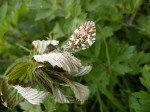Garlic Mustard or Jack-By-The-Hedge (Alliaria petiolata), see image 1, is the food plant for a charming butterfly, the Orange Tip (Anthocharis cardamines), what I feel is a quintessential sign of spring. The butterfly is seen from early April-early June, having just one generation a year. It is a butterfly that is rapidly migrating and colonising the north of the UK correlated with climate change, now being found throughout the UK and most of Scotland, except the far north, with just a few records coming from the Outer Hebrides and the Orkneys. The adults are seen along woodland rides and hedgerows, where the adults lay eggs on Garlic Mustard and in meadows, where adults prefer to lay eggs on Cuckoo flower (Cardamine pratensis). Adults usually fly a metre or so above the ground. The larva of the species over winters as a pupa, after the caterpillars have gone through 4 moults and 5 instars, and after eating mainly the nutritious seed pods of the species. The caterpillar is a velvety green see image 2.
- Image 1 Garlic Mustard © Dr A Culham The University of Reading
- Image 2 Orange Tip caterpillar © UK Butterflies Peter Eeles
- Image 3 Orange Tip showing the patterned underwing © Mathew Wisby The University of Reading
- Image 4 Orange Tip male showing upperside of wings © UK Butterflies Peter Eeles
- Image 5 Orange Tip female © UK Butterflies Peter Eeles
The species is easy to identify over the other white butterflies. For one, the hindwing from beneath is dappled with areas of greeny yellow, with areas of pure white with no uniform patterning, totally unlike any other native species of butterfly, see image 3. From above, males have pure white wings with brilliant orange wing tips, with a small area of faded black right at the very tip, see image 4. In the females, the wings are pure white with a small area of black at the wing tips, giving a superficially similar look to the Small White (Pieris rapae) see image 5. However, the distinguishing feature to separate the two species, is that there is an almost central black spot on the forewing of the Orange Tip, near its leading edge, not near the centre like the Small White. The males also have a black dot in the same place, but this is within the orange of the wingtip see image 4 and 5. The butterfly is also very small with a wingspan of between 38-45mm.
Fact: The caterpillar’s cannibalistic nature means it will eat the eggs of its siblings, which have not yet hatched!
Sites you may wish to visit are:
http://www.butterfly-conservation.org/
http://www.ukbutterflies.co.uk/index.php
http://www.hantsmoths.org.uk/index.htm
Please record any sighting on campus including the date, in the comments section below, for assessment by subsequent authors.
We thank photographers from UK Butterflies, Mathew Wisby and Alastair Culham for permission to use their images. Individual credits are given with each image.





